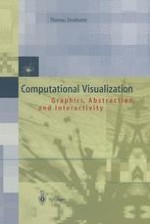1998 | OriginalPaper | Buchkapitel
Zoom Navigation
verfasst von : Prof. Dr. Thomas Strothotte
Erschienen in: Computational Visualization
Verlag: Springer Berlin Heidelberg
Enthalten in: Professional Book Archive
Aktivieren Sie unsere intelligente Suche, um passende Fachinhalte oder Patente zu finden.
Wählen Sie Textabschnitte aus um mit Künstlicher Intelligenz passenden Patente zu finden. powered by
Markieren Sie Textabschnitte, um KI-gestützt weitere passende Inhalte zu finden. powered by
Research on reducing the interaction effort when navigating in large information spaces has utilized Furnas’ generalized fisheye view [Fur86] in a variety of techniques (cf. Chap. 2). Existing approaches apply filtering and distorting techniques or both (recall Noik [Noi94]) according to the degree of interest (DOI) at a certain point in the information space (node). “Classical” fisheye views, as described by Sarkar and Brown [SB94], distort an existing layout to enlarge the view at the point of interest (focus). Distorting fisheye views stick more to the photographic nature of fisheye lenses by applying a nonlinear distortion to the display transformation. Filtering fisheye techniques display or suppress the rendering of nodes according to their DOI. Hybrid techniques, like the Intelligent Zoom as described by Bartram [BOD+94], make use of both, applying fisheye distortion to the display transformation as well as choosing an appropriate representation for each node not only depending on its DOI value, but also using reasoning techniques to exploit additional contextual information. Semantic zooming as described in [PF93] changes the appearance of objects, too, although only depending on the level of detail (LOD).
